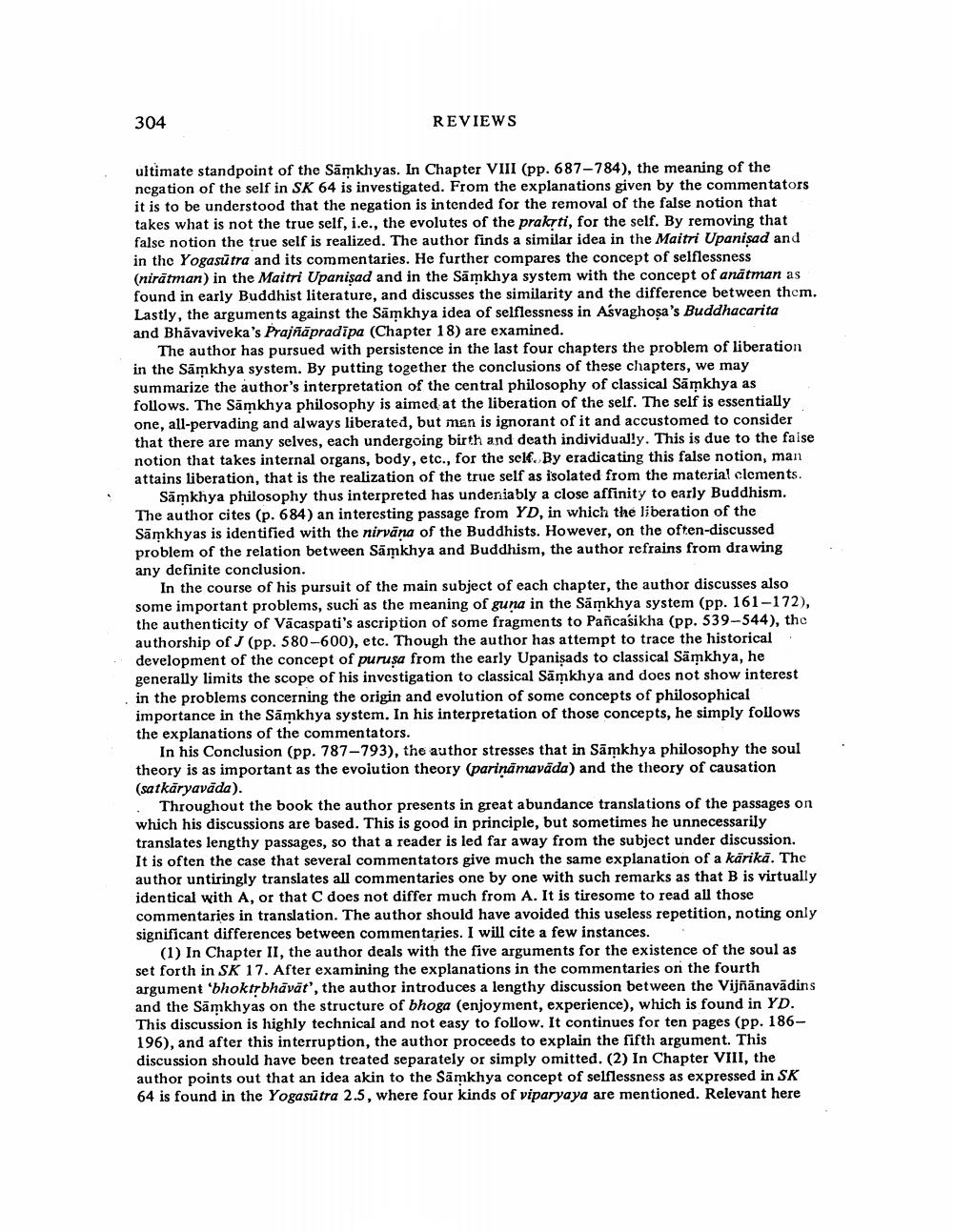________________
304
REVIEWS
ultimate standpoint of the Samkhyas. In Chapter VIII (pp. 687-784), the meaning of the negation of the self in SK 64 is investigated. From the explanations given by the commentators it is to be understood that the negation is intended for the removal of the false notion that takes what is not the true self, i.e., the evolutes of the prakti, for the self. By removing that false notion the true self is realized. The author finds a similar idea in the Maitri Upanisad and in the Yogasūtra and its commentaries. He further compares the concept of selflessness (nirätman) in the Maitri Upanisad and in the Samkhya system with the concept of anätman as found in early Buddhist literature, and discusses the similarity and the difference between them. Lastly, the arguments against the Samkhya idea of selflessness in Asvaghosa's Buddhacarita and Bhavaviveka's Prajñāpradipa (Chapter 18) are examined.
The author has pursued with persistence in the last four chapters the problem of liberation in the Samkhya system. By putting together the conclusions of these chapters, we may summarize the author's interpretation of the central philosophy of classical Samkhya as follows. The Samkhya philosophy is aimed at the liberation of the self. The self is essentially one, all-pervading and always liberated, but men is ignorant of it and accustomed to consider that there are many selves, each undergoing birth and death individually. This is due to the faise notion that takes internal organs, body, etc., for the self. By eradicating this false notion, man attains liberation, that is the realization of the true self as isolated from the material clements.
Samkhya philosophy thus interpreted has undeniably a close affinity to early Buddhism. The author cites (p. 684) an interesting passage from YD, in which the liberation of the Samkhyas is identified with the nirvana of the Buddhists. However, on the often-discussed problem of the relation between Samkhya and Buddhism, the author refrains from drawing any definite conclusion.
In the course of his pursuit of the main subject of each chapter, the author discusses also some important problems, such as the meaning of guna in the Samkhya system (pp. 161-172), the authenticity of Vācaspati's ascription of some fragments to Pancasikha (pp. 539-544), the authorship of J (pp. 580-600), etc. Though the author has attempt to trace the historical development of the concept of purusa from the early Upanişads to classical Samkhya, he generally limits the scope of his investigation to classical Sāmkhya and does not show interest in the problems concerning the origin and evolution of some concepts of philosophical importance in the Samkhya system. In his interpretation of those concepts, he simply follows the explanations of the commentators.
In his Conclusion (pp. 787-793), the author stresses that in Samkhya philosophy the soul theory is as important as the evolution theory (parināmavāda) and the theory of causation (satkāryavāda). . Throughout the book the author presents in great abundance translations of the passages on which his discussions are based. This is good in principle, but sometimes he unnecessarily translates lengthy passages, so that a reader is led far away from the subject under discussion. It is often the case that several commentators give much the same explanation of a kärikā. The author untiringly translates all commentaries one by one with such remarks as that B is virtually identical with A, or that C does not differ much from A. It is tiresome to read all those commentaries in translation. The author should have avoided this useless repetition, noting only significant differences between commentaries. I will cite a few instances.
(1) In Chapter II, the author deals with the five arguments for the existence of the soul as set forth in SK 17. After examining the explanations in the commentaries on the fourth argument 'bhoktrbhāvät', the author introduces a lengthy discussion between the Vijñānavādins and the Samkhyas on the structure of bhoga (enjoyment, experience), which is found in YD. This discussion is highly technical and not easy to follow. It continues for ten pages (pp. 186196), and after this interruption, the author proceeds to explain the fifth argument. This discussion should have been treated separately or simply omitted. (2) In Chapter VIII, the author points out that an idea akin to the Samkhya concept of selflessness as expressed in SK 64 is found in the Yogasutra 2.5, where four kinds of viparyaya are mentioned. Relevant here




